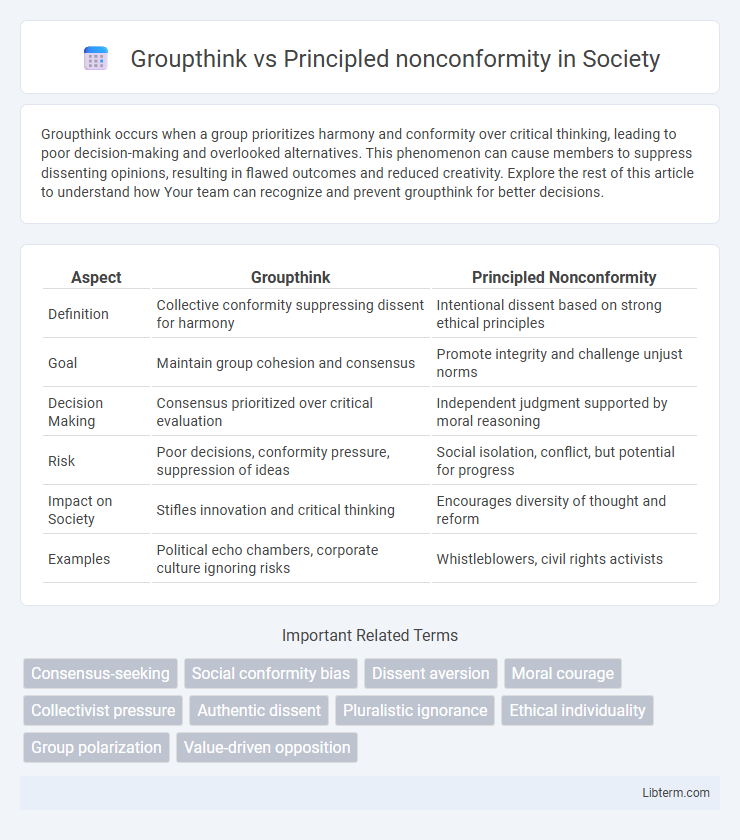Groupthink occurs when a group prioritizes harmony and conformity over critical thinking, leading to poor decision-making and overlooked alternatives. This phenomenon can cause members to suppress dissenting opinions, resulting in flawed outcomes and reduced creativity. Explore the rest of this article to understand how Your team can recognize and prevent groupthink for better decisions.
Table of Comparison
| Aspect | Groupthink | Principled Nonconformity |
|---|---|---|
| Definition | Collective conformity suppressing dissent for harmony | Intentional dissent based on strong ethical principles |
| Goal | Maintain group cohesion and consensus | Promote integrity and challenge unjust norms |
| Decision Making | Consensus prioritized over critical evaluation | Independent judgment supported by moral reasoning |
| Risk | Poor decisions, conformity pressure, suppression of ideas | Social isolation, conflict, but potential for progress |
| Impact on Society | Stifles innovation and critical thinking | Encourages diversity of thought and reform |
| Examples | Political echo chambers, corporate culture ignoring risks | Whistleblowers, civil rights activists |
Understanding Groupthink: Definition and Dynamics
Groupthink is a psychological phenomenon where the desire for harmony and conformity within a group leads to irrational or dysfunctional decision-making outcomes. It occurs when group members suppress dissenting opinions, prioritize consensus over critical analysis, and ignore alternative viewpoints, resulting in poor judgments. Understanding the dynamics of Groupthink involves recognizing symptoms such as self-censorship, illusion of unanimity, and pressure on dissenters, which collectively undermine effective problem-solving and creativity.
Principled Nonconformity: Meaning and Motivation
Principled nonconformity reflects a deliberate choice to challenge prevailing group norms based on deeply held values and ethical convictions. This approach motivates individuals to promote critical thinking and innovation by resisting consensus that compromises integrity or truth. Embracing principled nonconformity enhances decision-making processes and fosters environments where diverse perspectives drive progress.
Historical Examples of Groupthink and Nonconformity
Historical examples of groupthink include the Bay of Pigs invasion in 1961, where U.S. government officials ignored dissenting opinions, leading to a failed military operation. In contrast, principled nonconformity is exemplified by Rosa Parks' refusal to give up her bus seat in 1955, sparking the Civil Rights Movement by challenging societal norms. The Cuban Missile Crisis also demonstrates principled dissent, as some advisors opposed aggressive strategies, helping to avoid nuclear conflict.
Cognitive Biases Underlying Groupthink
Groupthink stems from cognitive biases such as confirmation bias, where individuals favor information confirming group consensus, and the illusion of unanimity, leading to the suppression of dissenting opinions. Anchoring bias causes members to rely heavily on initial group perspectives, while the bandwagon effect pressures conformity to avoid social rejection. Principled nonconformity challenges these biases by promoting independent critical thinking and encouraging diverse viewpoints to prevent flawed group decision-making.
The Role of Values in Principled Nonconformity
Principled nonconformity arises when individuals uphold core personal or ethical values despite external pressures to conform, fostering innovation and authentic decision-making. The role of values in principled nonconformity involves maintaining integrity and challenging groupthink by prioritizing truth and moral standards over social acceptance. This value-driven stance often leads to more diverse perspectives and resilient problem-solving within organizations and communities.
Psychological Consequences of Conformity and Dissent
Conformity in groupthink often leads to suppressed individual opinions, increasing the risk of poor decision-making and reduced creativity due to psychological pressure to agree. Principled nonconformity fosters cognitive diversity, enhancing critical thinking and resilience by encouraging dissent and safeguarding against collective biases. The psychological consequences of dissent include increased self-awareness and empowerment, while conformity can trigger internal conflict, stress, and diminished self-esteem.
Group Decision-Making: Pitfalls and Potential
Groupthink often leads to poor group decision-making as members prioritize consensus over critical evaluation, resulting in flawed outcomes and suppressed dissenting opinions. In contrast, principled nonconformity encourages diverse perspectives and critical thinking, enhancing problem-solving and innovation within teams. Recognizing the pitfalls of groupthink and fostering principled nonconformity can significantly improve decision quality and organizational effectiveness.
Cultivating Healthy Dissent Within Teams
Cultivating healthy dissent within teams requires balancing groupthink, which often suppresses individual opinions for conformity, with principled nonconformity that encourages genuine, respectful challenges to prevailing ideas. Encouraging an open culture where diverse viewpoints are valued reduces the risk of decision-making errors caused by groupthink, promoting innovation and better problem-solving. Leaders can facilitate this by establishing clear communication norms and rewarding constructive disagreement, fostering an environment where principled nonconformity thrives without fracturing team cohesion.
Strategies to Prevent Groupthink in Organizations
Organizations can prevent groupthink by encouraging open dialogue and fostering a culture where diverse perspectives are valued, ensuring decision-making processes involve critical evaluation and constructive dissent. Implementing structured techniques such as assigning a "devil's advocate" and facilitating anonymous feedback can reduce conformity pressure and promote independent thinking. Leadership commitment to transparency and inclusivity supports principled nonconformity, driving innovation and resilient organizational outcomes.
Balancing Unity and Constructive Nonconformity
Balancing unity and constructive nonconformity requires fostering an environment where groupthink is minimized by encouraging principled dissent and critical thinking. Promoting diverse perspectives enhances decision-making quality by preventing conformity pressures that stifle innovation and create blind spots. Effective leadership plays a crucial role in facilitating open dialogue, allowing principled nonconformity to coexist with team cohesion for optimal organizational performance.
Groupthink Infographic

 libterm.com
libterm.com